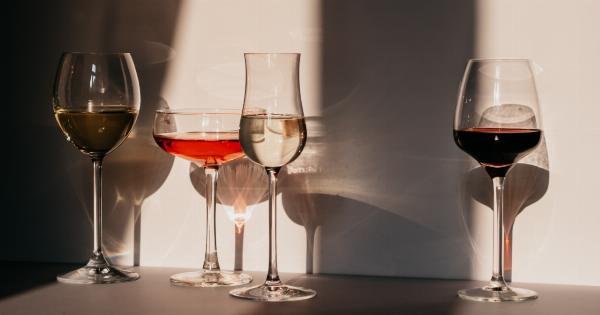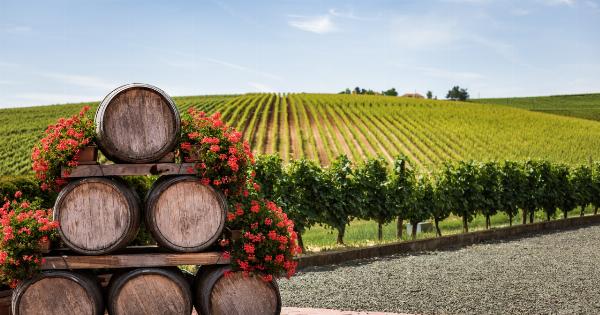Wine is a fascinating beverage that has been enjoyed for centuries. It is made from fermented grapes and has a complex flavor profile that varies depending on the type of grape, the region it was grown in, and the fermentation process.
Whether you are a wine connoisseur or just starting to explore the world of wine, this article will answer some of the most common questions about wine.
1. What are the different types of wine?
There are several different types of wine, each with its own unique characteristics. Some of the most popular types include:.
- Red Wine: Made from dark-colored grapes, red wine can range from light to full-bodied with flavors like cherry, blackberry, and chocolate.
- White Wine: Made from green or yellow grapes, white wine can be crisp and refreshing with flavors like citrus, pear, and peach.
- Rosé Wine: Made from red grapes, rosé wine has a pink hue and can be dry or sweet with flavors like strawberry, watermelon, and floral notes.
- Sparkling Wine: Known for its bubbles, sparkling wine can range from dry to sweet and includes famous varieties like Champagne and Prosecco.
- Dessert Wine: These sweet wines are often served with or as dessert due to their high sugar content. Examples include Port and Sauternes.
2. How is wine made?
Wine is made through a process called fermentation. Grapes are harvested and crushed to extract the juice, which is then fermented with the help of yeast.
Yeast consumes the sugars in the juice and converts them into alcohol, resulting in the creation of wine.
3. What factors affect the taste of wine?
Several factors can influence the taste of wine:.
- Grape Variety: Different grape varieties have distinct flavors and aromas, which contribute to the overall taste of the wine.
- Terroir: The region where the grapes are grown, including the soil, climate, and topography, can influence the flavor profile of the wine.
- Winemaking Techniques: The techniques used during fermentation, such as oak aging or malolactic fermentation, can impact the taste and texture of the wine.
- Vintage: The year the grapes were harvested can affect the taste, as weather conditions vary from year to year.
4. How should wine be stored?
Proper storage is crucial to preserving the quality of wine. Here are some tips:.
- Temperature: Wine should be stored at a consistent temperature between 45°F and 65°F (7°C and 18°C) to prevent spoilage.
- Humidity: The ideal humidity for wine storage is between 50% and 80% to keep the cork moist and prevent oxidation.
- Light: Wine should be stored in a dark environment to avoid degradation caused by UV rays.
- Position: Wine bottles should be stored horizontally to keep the cork moist and prevent air from entering the bottle.
5. How should wine be served?
Serving wine involves a few key considerations:.
- Temperature: White wines are best served chilled between 45°F and 50°F (7°C and 10°C), while red wines are typically served at room temperature between 60°F and 65°F (15°C and 18°C).
- Glassware: Wine is often served in specific glassware, such as a tulip-shaped glass for red wine or a smaller, narrower glass for white wine, to enhance the aroma and taste.
- Decanting: Some young red wines benefit from being decanted to allow them to breathe and soften before serving.
6. How long does wine last after opening?
Once a wine bottle is opened, its flavor and aroma can start to deteriorate due to exposure to air. The shelf life of opened wine depends on several factors:.
- Type of Wine: Light-bodied white wines and rosés are best consumed within 3-5 days, while full-bodied whites and red wines can last 5-7 days.
- Storage: Using a wine stopper or storing the opened bottle in the refrigerator can help prolong its freshness.
- Sparkling Wine: Opened sparkling wine should be consumed within 1-3 days, as the bubbles dissipate more quickly.
7. What are the health benefits of wine?
Wine, when consumed in moderation, can have some potential health benefits:.
- Heart Health: Red wine, in particular, contains antioxidants like resveratrol, which may help reduce the risk of heart disease.
- Antioxidants: Wine is rich in antioxidants, which can help protect the body against free radicals and oxidative stress.
- Mental Health: Moderate wine consumption has been associated with a reduced risk of cognitive decline and certain mental health disorders.
8. Can wine be enjoyed by people with dietary restrictions?
Wine is generally suitable for individuals with dietary restrictions, but it is essential to consider the following:.
- Gluten-Free: Most wines are naturally gluten-free, but some winemaking practices may introduce gluten-based products. Look for explicitly labeled gluten-free wines if necessary.
- Vegan or Vegetarian: Animal-derived products like gelatin or egg whites are sometimes used in winemaking. Look for vegan or vegetarian certifications on the wine label if needed.
- Sulfite Sensitivity: Some individuals may be sensitive to sulfites, which are naturally occurring compounds in wine. Select low-sulfite or sulfite-free wines if necessary.
9. How can one develop their wine palate?
Developing a wine palate takes time and practice. Here are some steps to improve your wine-tasting skills:.
- Attend Wine Tastings: Participating in wine tastings can expose you to a variety of wines and help you identify different flavors and aromas.
- Take Notes: Write down your observations when tasting wine, including the appearance, aroma, taste, and finish.
- Compare and Contrast: Taste different wines side by side to identify the unique characteristics of each.
- Read and Learn: Expand your knowledge about the different grape varieties, regions, and winemaking techniques to better understand wine.
+1. Is it necessary to spend a lot on wine?
The price of a bottle of wine can vary greatly, and expensive wines are not always superior in quality. It is possible to find excellent wines at affordable prices.
The key is to explore different regions, grape varieties, and winemakers to find wines that suit your palate without breaking the bank.






























